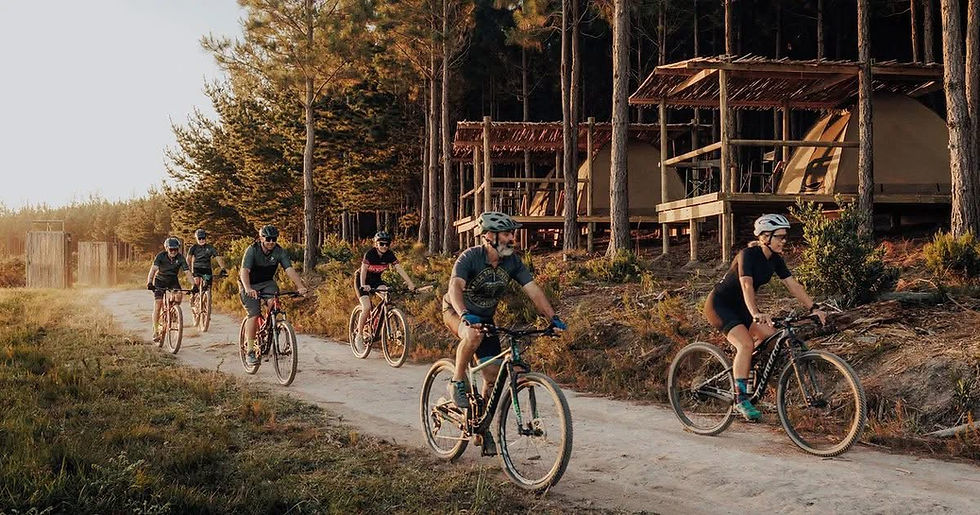Across the Namib
- RUN Magazine

- Aug 29, 2023
- 5 min read
In July 2022, ultra-runners Grobler Basson and Gabriel Kriel set out to run across the world's oldest desert, at its widest part. Grobler recounts how duct tape, cable ties and a sense of humor got them over endless dunes...

NAMIB DESERT ATTEMPT | MOVING TIME 26hrs 39min | TOTAL ELAPSED TIME 55hrs 17min | DISTANCE 170km | ELEVATION GAIN 4 898m
Monday afternoon, 5.57pm. Gabriel and I are sitting on the crest of a massive dune somewhere in the Namib Desert. Horizon to horizon, as far as the eye can see, is desert wilderness. Our minds are still trying to get used to this new normal.
There seems to be a stark contrast between the sun’s fading rays and our growing sense of humour as the heatof the day gets more manageable. While Gabriel’s makeshift duct-tape
and cable-tie reinforced gaiters are actually doing their job, there is an unspoken concern in both our eyes. Between us we only have a few drops of water left, no more food and no warm clothes – and the possibility of not finding our seconding crew is looming. Our only hope is that we and the crew somehow manage to get to the same set of coordinates,
an invisible location depicted by a set of numbers, somewhere across the massive dunes. The day started 11 hours ago. Up to this point we have managed 75 hard kilometres. We have tried to figure out how far we still have to go, but the reality is, we will get there when we get there. “There were no lies here,” to quote Terry Pratchett.
ALL FANCIES FLED AWAY
There is an old cliché that says “fail to prepare and you prepare to fail”. If there ever was a ‘showstopper’ to running across a desert, it would be managing your feet – more specifically, keeping sand out at all cost.
Having almost zero desert running experience between us, we looked at what runners do at races like the Marathon Des Sables. We opted for custom-made gaiters that fixed to our
shoes with velcro. The Altra Lone Peak 6 ALL WTHR was our go-to shoe. The only shortfall in this plan was that Gabriel only got into his shoes 24 hours before the mission started – and
3km into our ‘shake-out run’ he had already developed a couple of blisters where the stitches protruded on the inside of the shoes. His only other shoe was the Altra Escalate Racer. While it’s a fantastic lightweight road shoe, the mesh upper would simply be a sieve for the soft desert sand. Luckily, I had my Altra Mont Blancs there, and I always pack duct tape and cable ties… With that wrapped around his shoes, Gabriel was sand-proofed.
Monday evening, 7.35pm. Some call it luck, I call it grace, but our seconding team spotted our headlights as we crested a dune approximately 40 degrees off the point they were
expecting us. Thank you Ledlenser! After 83km we came running (read death marching) into an oasis of familiar faces, water and calories! A Monday to remember! And we’d be back out there to do it again the following day.

AS THE CROW FLIES
Let’s rewind a bit. Our mission was to set a Fastest Know Time (FKT) running across the Namib Desert at its widest part, east to west, in a straight line. Basically running as the crow flies.
However, the Namib Desert is a UNESCO World Heritage Site, and comes with various (and rightfully so) rules and regulations. One of which was an activity permit that only allowed
for daylight activity in the desert. This made our initial idea of running at night (for obvious reasons) null and void. We had to accept that we had dawn to dusk to work with.
The second-best option was to do it in the dead of winter, which in the Namib Desert is still like December in the Great Karoo. One of our main challenges was to accurately determine our best route. We had no idea how long it would take to traverse the desert. After considering many different options, we chose to keep it simple. We plotted GPS coordinates from our starting point (just north of Solitaire) straight to the Eduard Bohlen shipwreck on the
Skeleton Coast.

THE BELLY OF THE BEAST
Day one had packed a serious punch. However, we had made good time as the first 20km had some desert grasslands followed by what seemed like ‘moonscape’ rock sections with the big dunes only appearing at around 50km.
Our second day proved to hold the desert’s cruel reality. It was a whole different beast. Massive dune after dune after dune! As the day progressed our bodies started to operate on the edge of our energy systems, which lead to some spectacular lows and solid bonks. Add the relentless desert sun to the mix and you can quickly invite yourself to a pity party. We declined these invitations by sword fighting with oryx horns, capturing our low moments
on camera and even stalking some unsuspecting oryx. Seeing the humour in our predicament was often our only respite from the suffering. “It is just you, and what you believe.”
“If you put out 200 watts of power on each step, you could probably give 80 watts away to the desert for ‘sand-tax’”, was some of conversations we had. Our running often migrated to hands and feet as we climbed up the sandy giants. To add insult to injury, if you stopped climbing at the steepest part of the dunes, you would slide back down a couple of feet. Slowly but surely we shuffled and crawled our way across the belly of this beast. Day two was done. We’d managed around 50km in nine hours of moving time.
Even though Gabriel had used the fourth and final roll of duct tape, we felt a sense of relief that evening. Going into day three we knew what to expect and had covered most of the miles. It would most likely be our last day. There might or might not have been a ‘small’ party
in the middle of the desert that night. Gabriel and I retired to our tents at a respectable time but I can’t say the same for our seconding crew. When I woke up, Gabriel’s tent was 400m way from our camp (I told him to buy some earplugs).

A WILD FINISH
Day three, at around noon, we could see our final destination coming ever closer. The Eduard Bohlen. As we approached this eery shipwreck we briefly discussed what we’d each
experienced over the past three days. We realised how fortunate we were to have been able experience one of the world’s last untouched frontiers on foot. We felt humbled and blessed – and in desperate need of some rest and recovery. We removed our shoes and ran into the wild and icy waters of the Atlantic with a rush of endorphins and, true to tradition, champagne. Three tough days in Africa done!










